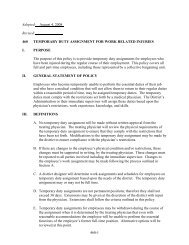Professional Learning Communities, Leadership and Student ...
Professional Learning Communities, Leadership and Student ...
Professional Learning Communities, Leadership and Student ...
You also want an ePaper? Increase the reach of your titles
YUMPU automatically turns print PDFs into web optimized ePapers that Google loves.
RMLE Online—Volume 28, No. 1attractive. The idea that adults in schools must be learners for students to learn sounds simplistic but, in fact,this has often not been the norm in many schools. Creating a learning community for adults requires a newform of professional development. According to Sparks <strong>and</strong> Hirsh (1997), “This staff development not onlymust affect the knowledge, attitudes, <strong>and</strong> practices of individual teachers, administrators, <strong>and</strong> other schoolemployees, but it also must alter the cultures <strong>and</strong> structures of the organizations in which those individualswork” (p. 2). Teachers have often considered professional development days a waste of time because a shotgunapproach has been used to introduce teachers to new ideas that came from someone else without teacherinput <strong>and</strong> often resulted in no follow through or support to implement the innovation <strong>and</strong> new strategy.Teachers were almost never given an opportunity to create their own meaning <strong>and</strong> underst<strong>and</strong>ing about thenew strategy or practice, much less dialogue with their colleagues about the possible benefits of such a practiceas it relates to student learning <strong>and</strong> their own beliefs about student learning.The benefits of collaboration have been addressed through both quantitative <strong>and</strong> qualitative studies.Rosenholtz (1989) may have been the first researcher to attempt a large-scale statistical analysis of the relationshipbetween teacher collaboration <strong>and</strong> student achievement. Quantitative data gathered from herstatewide representative sample of 78 elementary schools in eight school districts show that collaboration is astrong predictor of student achievement gains in reading <strong>and</strong> math. The gains were measured with one cohortof students from second through fourth grades. A regression analysis controlled for school socioeconomic status,school size, teacher experience, teachers' verbal ability, <strong>and</strong> pupil-teacher ratio.Little (1982) conducted case studies of four schools identified as successful on the basis of student achievementon st<strong>and</strong>ardized achievement scores <strong>and</strong> two schools identified as unsuccessful on the basis of the samecriteria. She found that the successful schools were characterized by frequent teacher evaluation <strong>and</strong> feedback,teachers talking with one another about teaching, teachers working together to design their classes, <strong>and</strong> teachersteaching each other about teaching. All these collaborative practices were conspicuously absent in theunsuccessful schools (as cited in Smith & Scott, 1990, p. 16).The Impact of <strong>Leadership</strong> on the Creation of <strong>Professional</strong> <strong>Learning</strong> <strong>Communities</strong>In Turning Points 2000, Jackson <strong>and</strong> Davis (2000) state that “no single individual is more important to initiating<strong>and</strong> sustaining improvement in middle grades school students' performance than the school principal” (p. 157).Never before in the history of education has there been such a clarion call for leaders who can create a culturethat fosters both adult <strong>and</strong> student learning <strong>and</strong> exp<strong>and</strong>s the definition of leadership to include all stakeholders inthe school. Louis <strong>and</strong> Kruse (1995) have identified the supportive leadership of the principal as one of the necessaryhuman resources for schools to become a professional learning community. Prestine (1993) suggests threefactors necessary to create professional learning communities in schools. Principals must have the ability to shareauthority, facilitate the work of the staff, <strong>and</strong> have the ability to participate without dominating.<strong>Professional</strong> learning communities are identified by professional collaboration to improve student learning.According to Leonard & Leonard (2001):<strong>Professional</strong> collaboration is evidenced when teachers <strong>and</strong> administrators work together, share theirknowledge, contribute ideas, <strong>and</strong> develop plans for the purpose of achieving educational <strong>and</strong> organizationalgoals. In effect, collaborative practice is exemplified when school staff members cometogether on a regular basis in their continuing attempts to be more effective teachers so that their studentscan become more successful learners. (p. 10)Louis <strong>and</strong> Kruse (1995) maintain that a core characteristic of the professional learning community is an unwaveringfocus on student learning. Educational leaders certainly want <strong>and</strong> need to develop teacher leaders whowill be committed to action <strong>and</strong> converted into agents of change if they are going to meet the challenges facingeducators today. Senge (2000) talks about the impetus for change often coming first from the principal. He refersto principals becoming a “lead teacher <strong>and</strong> lead learner, <strong>and</strong> steward of the learning process as a whole” (p. 15).© 2004 National Middle School Association 4




